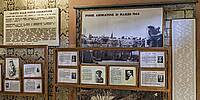© 2023 Toni Garbasso, All Rights Reserved.
A museum is not only a container of beautiful, ancient, or rare things, but above all it is a collector of memories. For the panorama I am presenting, the memory collector is the Historical Museum of the Liberation, in via Tasso, Rome.
The building was not born as a museum, but as a civil building in the "rationalist" style at the end of the 1930s.
It was then leased to the German Embassy and housed the cultural office and the police officer, but after 8 September 1943, the date on which Italy signed the armistice with the Allies and consequently with the occupation of Italy by the Wehrmacht and the SS, it became the Aussenkommando (outside head office) of the SS, and the apartments at number 145 were transformed into a prison used by the SS in Rome.
Here soldiers, partisans, political prisoners, ordinary citizens rounded up, victims of a brutal and bloody repression were imprisoned and tortured.
In 1955 it was inaugurated as the Historical Museum of the Liberation.
The rooms today retain the structure and layout of the time, the cells with the tapestry of the time are now filled with documents, images and memorabilia relating to the function of the prison, its inmates and the main events linked to the Nazi-fascist occupation and Resistance.
I selected Cell No. 1, the largest, in which many of those killed at the Fosse Ardeatine were imprisoned, including a priest, Don Pietro Pappagallo.
The objects and documents on display are dedicated to their memory, from brief profiles of the fallen and those decorated for valour, to personal effects found on their remains when they were exhumed at the end of July 1944.
A museum in order not to forget the atrocities of the Nazi/fascism and of the war.
(see it in full resolution here.)
Nikon D800E, 16mm fisheye, HDR made in PTGui.
Un museo non è soltanto un contenitore di cose belle, antiche o rare, ma è soprattutto un raccoglitore di memorie. Nella panoramica che presento, il raccoglitore di memoria è il Museo storico della Liberazione, a via Tasso, Roma.
L’edificio non nasce come museo, ma come una palazzina civile in stile “razionalista” alla fine degli anni Trenta. Fu da subito ceduta in affitto all’Ambasciata tedesca e ne ospitò l’ufficio culturale e quello dell’addetto di polizia, ma dopo l’8 settembre 1943, data in cui l’Italia firmò l’armistizio con gli Alleati e di conseguenza con l’occupazione dell’Italia della Wermacht e delle SS, divenne sede dell’Aussenkomando delle SS e gli appartamenti del civico 145 furono trasformati in carcere delle SS a Roma.
Qui furono incarcerati e torturati soldati, partigiani, prigionieri politici, cittadini comuni rastrellati vittime di una repressione brutale e sanguinaria.
Nel 1955 fu inaugurato come Museo storico della Liberazione.
I locali conservano oggi la struttura e la planimetria dell’epoca, le celle con la tappezzeria dell’epoca oggi sono riempite con documenti, immagini e cimeli relativi alla funzione di prigione, ai suoi reclusi e ai principali eventi legati all'occupazione nazifascista e alla Resistenza.
Ho scelto la Cella n.1, la più grande, in cui furono reclusi molti di quelli che furono trucidati alle Fosse Ardeatine fra cui anche un prete, don Pietro Pappagallo.
Alla loro memoria sono dedicati gli oggetti ed i documenti esposti, da brevi profili dei caduti e ai decorati al valore, sino ad effetti personali trovati sui loro resti quando furono riesumati a fine luglio 1944.
Un museo per non dimenticare le atrocità del nazi/fascismo e della guerra.
(vedi la versione in alta definizione qui.)



 Tap or click the zoom icon in the bottom right corner of the picture to switch between in-page and fullscreen view
Tap or click the zoom icon in the bottom right corner of the picture to switch between in-page and fullscreen view